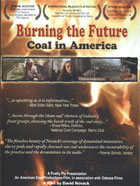
Burning the Future: Coal in America 2008
Distributed by The Video Project, PO Box 411376, San Francisco, CA 94141-1376; 800-475-2638
Produced by David Novack, Alexis Zoullas
Directed by David Novack
DVD , color, 120 min.
Sr. High - Adult
Appalachian Studies, American Studies, Environmental Studies
Date Entered: 09/09/2009
Reviewed by Charles Burkart, Media Bibliographer, West Virginia University, Morgantown, WVThere are a number of excellent documentaries available on mountaintop removal in Appalachia. These include Robert Gates, All Shaken Up (1998) and Catherine Pancake’s Black Diamonds: Mountaintop Removal and the Fight for Coalfield Justice (2006). Now we can add one more: Burning the Future: Coal in America (2007)
Burning the Future: Coal in America follows the same format as these earlier coal documentaries with its mix of interviews, expert commentary, filmed community meetings, television footage and onsite filming of coal extraction operations. Although pro-industry views of coal company executives and politicians are presented, Burning the Future: Coal in America is definitely subtle propaganda for the ecological “green” movement. However, in the impoverished region of Southern West Virginia, one has to balance the need for employment against environmental destruction. Nevertheless, the documentary makes clear that while coal tonnage has increased, the number of coal mining jobs has actually declined from over 100,000 in the 1940s to 15,000 today.
Perhaps, the most valuable single section of the documentary was “Water in Mingo County” which graphically demonstrated the poisoning of the local water supply. The expert commentary of ecologist Dr. Ben Stout, of Wheeling Jesuit University, was also informative and very persuasive. Finally, Maria Gunnoe, who had an important role in Catherine Pancake’s Black Diamonds, makes a re-appearance in ,em>Burning the Future: Coal in America. She could almost be said to have the starring role in the documentary. She makes an affective case, although I find her claim to be saving a unique mountain culture to be less pertinent than the slow poisoning of the local people and the destruction of the Appalachian ecosystem.
This is a high quality well produced documentary with a variety of camera angles, aerial photography, montages, animation, television clips, etc. The color is vivid and the sound is crystal clear. The film moves at a rapid pace and is extremely well edited.
If I have any criticism of Burning the Future: Coal in America, it is its 120 minute length. The documentary could have been shortened. In particular, I felt the final trip to New York by the local activists could have been edited out without affecting the programs overall quality. Fortunately, the DVD is divided into convenient chapters, which makes the excessive length irrelevant.
Short “special features” were also provided on DVD: Coal and Energy, Coal & Climate Change, Pollution and Public Health, and Democracy in Action. Of these five to ten minute extras, I found the Pollution and Public Health Section to be the most useful.
Burning the Future: Coal in America has won a number of prizes, including the Pare Lorentz Award for Best Social Documentary of 2008, and a Clarion Award for Communication of Diversity, Sustainable Development and Ethical Debate. Despite the documentary’s somewhat preachy quality, Burning the Future: Coal in America is highly relevant and important. It very pertinent to West Virginia and I highly recommend its purchase by both public and university libraries within the Mountain State. The documentary really should be seen wherever coal mining operations take place –West Virginia, Wyoming, Pennsylvania, Kentucky. It is a model of its type and will be useful for years to come.